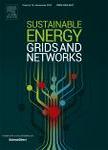版权所有:内蒙古大学图书馆 技术提供:维普资讯• 智图
内蒙古自治区呼和浩特市赛罕区大学西街235号 邮编: 010021

作者机构:Isfahan Univ Technol Dept Elect & Comp Engn Esfahan *** Iran
出 版 物:《SUSTAINABLE ENERGY GRIDS & NETWORKS》 (Sustain. Energy Grids Netw.)
年 卷 期:2020年第22卷
核心收录:
学科分类:0820[工学-石油与天然气工程] 0808[工学-电气工程] 08[工学] 0807[工学-动力工程及工程热物理]
主 题:Conjugate active and reactive power management Electric vehicles Mixed-integer linear programming Smart distribution network operation
摘 要:Electrical Vehicles (EVs) have a growing penetration rate in many countries aimed at the reduction of fossil fuel consumption and declining environmental issues. The high penetration rate of EVs, as new electrical energy demands, can cause operational problems for distribution networks. Therefore, designing and implementation of monitoring and management mechanisms for EVs charging is a necessity. EVs are equipped with power electronic-based chargers, bringing them a high degree of flexibility in conjugate active and reactive power control. This capability can be employed not only to reduce the adverse impacts of the high penetration rate of EVs on distribution networks operation but also to support the active and reactive management in distribution networks. In this paper, to employ EVs conjugate active and reactive power control capability, a model for central active and reactive power management in a smart distribution network is proposed. The proposed model is an optimization problem in which the objective function consists of two terms, namely, minimizing the cost of energy and improving the voltage profile, over the operation planning horizon. The constraints of the optimization problem include distribution network operation constraints and charging and discharging constraints related to the EVs batteries and chargers. This problem is modelled as a Mixed Integer Linear Programming (MILP) problem and is implemented on the 33-bus, 69-bus, and 133-bus distribution networks. The results show that the proposed model can obtain the lowest energy cost and energy loss and the best operational voltage profile in a completely acceptable calculation time. Moreover, by using the proposed model, supplying the required energy for EVs during their plugin time interval is guaranteed and, increasing the penetration rate of EVs into the network is facilitated. (c) 2020 Elsevier Ltd. All rights reserved.